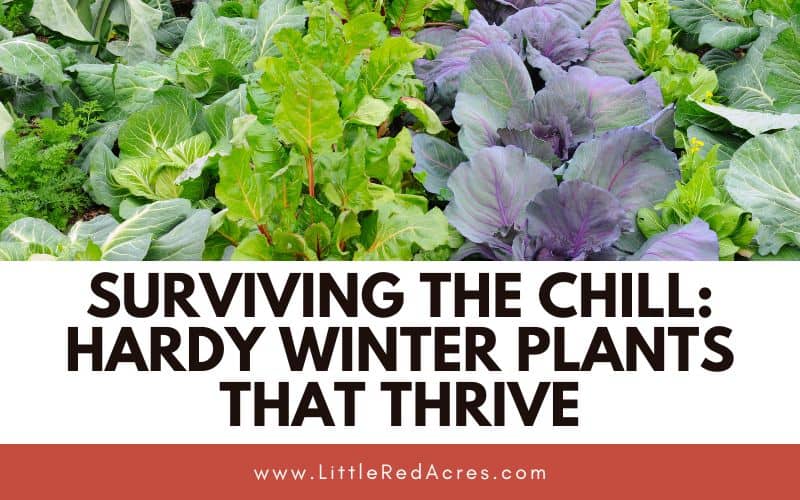Surviving the Chill: Hardy Winter Plants That Thrive
Inside: These resilient winter plants flourish even in chilly conditions. Here are tips for selecting hardy varieties for a thriving weather garden.
Winter is often considered a dormant period for gardening, but here is an opportunity to harvest fresh produce during the colder months. With the right selection of plants and a little bit of planning, you can keep your garden flourishing through the colder months. Knowing what to winter plants to pick is key to making the most out of the season.

This post may contain affiliate links, see my disclosure policy for more information.
Hardy Winter Plants That Thrive
Winter gardening has many benefits.
- It allows you to take advantage of cooler temperatures, reducing the need for watering.
- Winter plants can often be more resistant to pests and diseases than their summer counterparts.
- Fresh produce from your winter garden is not only delicious but also nutritious, adding to your overall health and well-being.
- It reduces your grocery costs on things you normally buy throughout the winter
It's best to start most seeds in mid to late summer or early fall. This gives them time to mature before the cool weather kicks in.
Get updates & freebies delivered to your inbox!
Cold-Resistant Vegetables
When choosing vegetables for a winter garden, it is important to select those that can withstand cold temperatures. Some popular cold-resistant vegetables include:
Broccoli: This vegetable can withstand temperatures as low as 20°F and can even improve in flavor after a frost.
Brussels sprouts: These vegetables can tolerate temperatures down to 20°F and can be harvested well into the winter.
Carrots: This root vegetable can tolerate temperatures down to 20°F and can be harvested throughout the winter if protected with a layer of mulch.
Kale: This leafy green can tolerate temperatures down to 20°F and can even improve in flavor after a frost.
Spinach: This leafy green can tolerate temperatures down to 15°F and can be harvested throughout the winter if protected with a layer of mulch.
Garlic: A frost-resistant bulb suited to fall rooting, garlic can be planted roughly six weeks before a deep freeze for peak growth.
Radishes: It's a great vegetable to plant in the fall in an area that doesn't get too cold come winter. But, the vegetable can still flourish through frost spells.
Lettuce: There are several varieties of winter lettuce available which are specifically cold hardy and able to grow in low light conditions.

Winter-Friendly Flowers
Winter-friendly flowers can add color and beauty to a winter garden. Some popular winter-friendly flowers include:
Pansies: These flowers can tolerate temperatures down to 10°F and come in a variety of colors.
Snowdrops: These flowers can tolerate temperatures down to 0°F and are one of the first flowers to bloom in the winter.
Crocuses: These flowers can tolerate temperatures down to -10°F and come in a variety of colors.
Hellebores: These flowers can tolerate temperatures down to -20°F and bloom in late winter.
When picking plants for a winter garden, it is important to constantly consider your gardening zone and the specific conditions of the garden. By choosing cold-resistant vegetables and winter-friendly flowers, a winter garden can thrive even in the coldest months of the year.
One of the key factors to success is selecting the right crops for the winter season. Vegetables such as kale, spinach, and Brussels sprouts are hardy and can withstand cold temperatures. The next important factor is where you grow them.
There are many ways to garden through the winter: cold frame, greenhouse, undercover, and in your garden.
When it comes to planting, spacing, and timing are crucial. Ensuring that plants have enough room to grow and are planted at the appropriate time can make all the difference in their success. In a lot of ways, it is similar to gardening during the rest of the year.
FAQ
When should I start planting a winter garden? Winter vegetables need a solid start before winter arrives because once cold, dark days settle in, plants won't grow like they do in the summer months. The general rule of thumb for planting a winter vegetable garden is to start your plants 6-8 weeks before the last frost.
What vegetable takes the least time to grow? Radishes. One of the fastest-growing vegetable plants you can grow is radish. Some types are ready to eat in as little as 3 weeks from seeding.
What vegetables do not need sunlight to grow? Salad greens generally do well in cooler weather and they welcome some shade!

Want More?
Benefits of Gardening for Mental Health
How to Build Raised Garden Beds






